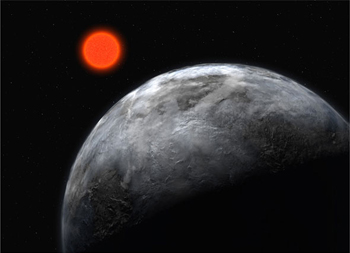Jet Propulsion Laboratory (Planetquest): April 25, 2007: European astronomers this week announced the discovery of a potentially habitable planet about 1.5 times larger in diameter than Earth, orbiting a star very different from our sun.

Above: Artist's concept of the five-Earth mass planet circling the red dwarf star Gliese 581.
(ESO image)
The planet circles the star Gliese 581 c, located 20.5 light-years away in the constellation Libra, and completes a full orbit in 13 days. Its discovery appears to confirm the existence of terrestrial planets, which are the study target for NASA's future planet-finding missions.
"We now know there are Earthlike planets in the habitable zone, at least in some of the smaller, nearby stars," said Dr. Charles Beichman, executive director Caltech's Michelson Science Center. "This is an exciting step along the way to characterizing these kind of planets, which is the ultimate goal of NASA's SIM PlanetQuest and Terrestrial Planet Finder missions."
SIM PlanetQuest, a mission expected to launch within the next decade, will be able to study such planets in more detail and be capable of detecting Earthlike planets around sun-like stars. It will be followed by the Terrestrial Planet Finder (TPF) observatories, which will study the atmospheres of Earthlike worlds and search for the chemical signatures of life.
Although 211 planets have been discovered to date beyond our solar system, this planet is the first that is assumed to be rocky in composition, like Earth, and also residing in what is known as the habitable zone - the region around a star where the temperature is right for water to be present in liquid form. Because the host star is smaller and colder than the sun, its habitable zone is much closer than the Earth-sun distance.
Determining whether planets such as this one are truly Earthlike will depend on follow-up study by more advanced, spaceborne telescopes, said Dr. Victoria Meadows, a member of a team that helped define science requirements for Terrestrial Planet Finder.
"More planets like this will be found. What TPF can bring to the table now is the capability to characterize them. We'd like to know whether it has an atmosphere and what that atmosphere is made of. Does it have water vapor? Does it have the chemical signatures of life? TPF will be able to tell us what the environment of a planet is, definitively," Meadows said.
Gliese 581 was already known to harbor a Neptune-mass planet, and astronomers also have strong evidence for the presence of a third planet of about eight Earth masses.
The team of Swiss, French and Portuguese scientists made the discovery using the High Accuracy Radial Velocity for Planetary Searcher (HARPS), located on the European Southern Observatory's 3.6-m telescope at La Silla, Chile. The instrument searches for planets indirectly by observing the back-and-forth "wobble" of stars caused by the gravitational effect of unseen planets.
|
